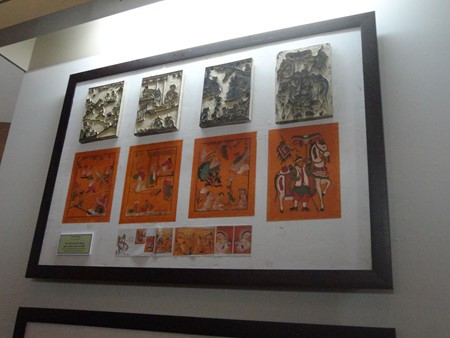(VOVworld) – Kim Hoang folk paintings which originates in Kim Hoang village, Hoai Duc district, Hanoi, flourished from the 18th to the 19th century. They mostly portray fixtures in the simple lives of people in the northern delta region, such as buffaloes, pigs, chicken, and village life on the Lunar New Year.
Kim Hoang is a prominent kind of folk painting in the northern delta region. Different from Dong Ho and Hang Trong paintings, which are printed on white and yellowish paper, Kim Hoang paintings are called red paintings because they are printed on scarlet paper. Le Bich, a connoisseur of folk pictures, said he was really impressed with the Kim Hoang style: "Kim Hoang is most recognizable by its red color. I very much like pictures depicting pigs and chicken. The plain sketches of pigs on a red background are very familiar to Vietnamese people. They remain beautiful even now thanks to their artistic value.”
 |
| Kim Hoang paintings exhibited at the Hanoi Museum (Photo: Quynh Hoa/VOV5) |
Woodblocks used for printing Kim Hoang paintings were made from jack tree trunk or canary-wood with sophisticated carvings. Villagers say in the early 20th century, after the harvest in October, Kim Hoang residents were in an eager bustle making paintings. Scarlet paper was bought at Hang Ma Street in Hanoi. After ink from the woodblocks was applied, the paper was slightly rubbed to polish up the lines and dried. Then, the pictures were colored with brushes, which were made from straw. Kim Hoang paintings look childish and animated. Folk painting collector Nguyen Thi Thu Hoa said:“Kim Hoang paintings with simple lines, sketches, and colors were produced in a suburban village and fitted the tastes of laborers. They bought Kim Hoang paintings and vertical red sentences to hang in their houses during the Lunar New Year Festival to wish for good luck. Kim Hoang colors are made from minerals, so they look natural and clear."
On the left corner of many paintings, there are poems or vertical sentences written in Chinese characters, creating unique feel.
Today, Kim Hoang folk paintings are fading away as very few families preserve the woodblocks and engage in this line of work. Collector Thu Hoa said that in 1915, a devastating flood destroyed Lien Mac Dyke and washed away many woodblocks by Kim Hoang villagers. Hoa is the owner of 80 Kim Hoang paintings, including 20 newly restored ones. She said:“The Kim Hoang woodblock carvings are very beautiful, such as those portraying wrestling people or fairies. It takes time to revive this kind of folk paintings.
Kim Hoang folk paintings used to be an indispensable spiritual food for the people in the northern delta.